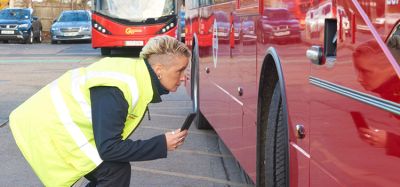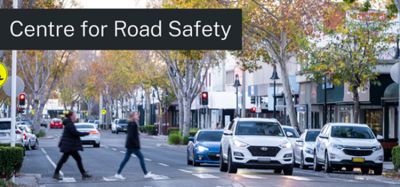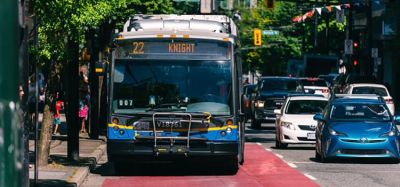Transport Technology: The pace of technology change
- Like
- Digg
- Del
- Tumblr
- VKontakte
- Buffer
- Love This
- Odnoklassniki
- Meneame
- Blogger
- Amazon
- Yahoo Mail
- Gmail
- AOL
- Newsvine
- HackerNews
- Evernote
- MySpace
- Mail.ru
- Viadeo
- Line
- Comments
- Yummly
- SMS
- Viber
- Telegram
- Subscribe
- Skype
- Facebook Messenger
- Kakao
- LiveJournal
- Yammer
- Edgar
- Fintel
- Mix
- Instapaper
- Copy Link
Posted: 12 March 2015 | Mark Cartwright, Managing Director, RTIG
It is a truth universally acknowledged that we are living in a time of unparalleled rapidity in technology change, writes Mark Cartwright, Managing Director of RTIG. New tools, systems and devices come on to the market with the frequency, and impact, of machine gun bullets. What’s more, it’s all connected, so that a minor improving in fabricating (say) organic LEDs or photovoltaic cells can suddenly lead to a revolution in lifestyle, and push whole continents into boom or bust. Well, maybe. I won’t deny that there is a lot happening, but for various reasons the impact will be a lot less dramatic than that. To argue the point, I’m going to make use of a few historical references within this article, all linked in some way to transport (and transport technology in particular)…


The transport technology life-cycle
The late Douglas Adams is best known for his science fiction humour, but he was also a shrewd observer of technology change. In a 2001 radio programme (‘The Hitchhiker’s Guide to the Future’) he said this:
“When new media arrive they don’t necessarily replace or eradicate previous types… Generally, old media don’t die. They just have to grow old gracefully. Guess what, we still have stone masons. They haven’t been the primary purveyors of the written word for a while now of course, but they still have a role because you wouldn’t want a TV screen on your headstone.”
This analysis is linked to the concept of the ‘technology adoption lifecycle’, which describes the evolving impact of innovations over time. Academic studies go back at least to the 1950s, originating (as far as I can tell) in models of agricultural development. The idea is that innovations start out as basic research, get prototyped and market tested, then become successively picked up by different sections of the community: pioneers (who just want the latest thing), early adopters (who can justify spending a premium), mainstream (when it’s become widespread), and finally obsolescence.
The total duration of the cycle varies a lot, but is inevitably a lot longer for major disruptive innovations than for minor variations. Last year’s car may be out-dated by this year’s model, but it took most of a century for cars to go from pioneer to mainstream.
I’ve written previously about the impact of this in transport ticketing. Smart ticketing is now possible, and it’s not hard to come up with a creative use of technology for this purpose. But cash tickets are still dominant for many services, and mobile ticketing is still at the early-adopted stage, even for airlines.
A similar argument applies to travel information. The fact that real-time information is available through smartphone apps shouldn’t blind us to the fact that the most popular application is the at-stop/at-station display. That’s where people want it, especially for bus.
Don’t believe me? The independent consumer body, Passenger Focus, has studied how tech-savvy young people go about their travel. They love playing on their smartphones – but they want to use them for fun, to chat with their friends and so on. They don’t want to interrupt this to check on their bus.
I’m not suggesting that you shouldn’t explore the opportunities offered by technology innovation. Just don’t be surprised if you need to keep the existing facilities operational for many years yet.
Behaviour change
It’s important, then, to think not just about how a new technology could be used – its technical feasibility – but also about how it will be used, by real people, making real journeys in the real world. A successful technology innovation will necessarily involve a change in consumer behaviour.
Behaviour has a notorious degree of inertia. People need a jolt to change from their familiar, habitual way of doing things. Technology can help here: providing an opportunity to engage with travellers in novel ways, both directly and by leveraging peer-pressure (“Hey, look what I can do on my new system! You should try it.”).
Which brings me to my second historical reference; during World War II, economies were under serious stress, and a lot of political energy was used in getting people to behave in ways which would help the war effort.
Poster propaganda was not new, but it was used in new ways. One famous American poster bore the slogan ‘when you ride alone, you ride with Hitler…join a car-sharing club today!’ The implication of this, of course, is that a solo driver is selfish and not acting in the best interests of the country.
I don’t have any figures on how significant the impact of this campaign was at the time. What is clear, though, is that there was no lasting impact on travel behaviour. Within my lifetime, the pressure to car-share, or car-pool, has come mainly from the oil price shocks of early 1970s and the mid-2000s. Car-clubs seem to be growing again today, but their share of the transport market is still pretty small.
So, people’s behaviour tends to be conservative. In public transport, the primary expectation is for a scheduled service, running to pre-planned routes. Passengers want them to be punctual, stable over time, clean, safe, and (preferably) cheap. Most other things are nice-to-haves.
Again, I don’t mean to imply that you can make do with just running a box on wheels. Passengers certainly value information, and from a marketing perspective (both strategic and tactical) it is well worth while to use the available tools – including new opportunities like social media – to maintain the profile of public transport. But it is, in a fundamental sense, still the same service offering.
Changing climate
My final citation goes further back, to the end of the 19th century. Ambrose Bierce was a newspaperman with a strong satirical streak. His most famous product was a volume called ‘The Devil’s Dictionary’, based on a collection of his columns from 1881 onwards.
A typically cynical entry is the one for ‘Reporter’: ‘A writer who guesses his way to the truth and dispels it with a tempest of words’. (Of course Eurotransport is an exception to this otherwise sound rule…) More on topic we have ‘RAILROAD, n. The chief of many mechanical devices enabling us to get away from where we are to where we are no better off. For this purpose the railroad is held in highest favour by the optimist, for it permits him to make the transit with great expedition.’
Clearly, the heady days of George Stephenson, when the mere fact of a public railway was exhilarating, were long gone by Bierce’s time.
But how about this definition: “ELECTRICITY, n. The power that causes all natural phenomena not known to be caused by something else…Electricity seems destined to play a most important part in the arts and industries. The question of its economical application to some purposes is still unsettled, but experiment has already proved that it will propel a street car better than a gas jet and give more light than a horse.”
How about that – electric vehicles as the future, predicted well over 100 years ago!
OK, it didn’t quite work out like that. Karl Benz, Henry Ford and others were innovating in a different space, and as it turned out their way was technically, commercially, and socially superior.
I draw two lessons from this. The first is that no one has a monopoly on smart thinking. The biggest problem during the dot-com bubble of the early 2000s, arguably, was the excessive valuation of innovation companies who forgot that other people might have very similar ideas. The big survivors succeeded primarily by vigorously building credibility in a small number of clear service concepts: information search (Google), retail (Amazon), banking (PayPal) and chatting with friends (Facebook).
When thinking about technology deployment, therefore, look at what others are doing, including how well they are doing it. Of course system suppliers will make bold claims about the potential for their products, and it’s easy to get sucked into the general enthusiasm. But even if you can afford to do everything that’s offered, your service is unlikely to benefit from a ramshackle pile of unconnected technologies. A case in point: many operators (though not all) are finding that a Facebook-presence is not that helpful. In any case, a lot of younger people are moving away from Facebook (perhaps because it is being colonised by their parents) onto other social platforms.
The second lesson is, to twist Douglas Adams’ words quoted earlier, that innovation doesn’t go away. Electric vehicles have done well on tracks; and although they have not made much headway in the road environment, they are firmly back on the agenda today. The political climate has changed, in part because of concerns for the meteorological climate.
To sum up, changing technology changes things, but in a complex way. Long-term trends of geopolitics, conservatism in behaviour, and social convention are tangled with the commercial realities of investment in innovation, development and market adoption.
Technology innovations may be (almost) instantaneous – if sometimes unpredictable – and may open up exciting new visions, but the impact can take years. Even game-changers like smartphones and social media are entering (or close to) their second decade with relatively limited effect on most people’s travel.
So what do the next few years look like? Probably much like this year. Some technologies will continue to make progress, while others will die a quiet death. You probably need to keep your eyes open, but don’t worry too much about being left behind.
Beyond that, I’ll fall back on a final Douglas Adams quote:
‘I refuse to answer that question on the grounds that I don’t know the answer’.
About RTIG
RTIG is a collaborative association of local authorities, public transport operators and systems/service providers. Its aim is to facilitate better public transport operations and a better passenger experience, through the use of technology systems. It does this through developing system specifications and good-practice guidance, and through topic-focussed community events. While RTIG is a UK-based organisation, it is not just for UK stakeholders; members are drawn from across the world, not just in mainland Europe but as far afield as the USA and Australia. It is RTIG’s ambition to reflect as wide a range of interests as possible, and it is always open to new members. If you are interested in becoming a member of RTIG then please visit our website at www.rtig.org.uk or contact us at [email protected].
Biography
For the past 20 years, Mark Cartwright’s main focus has been intelligent transport systems and standards, specifically in the management of national initiatives.
He is Managing Director of the public transport community RTIG, where he has led operations since 2004. He also has interests in traffic management and other ITS. Mark began his professional life in the academic world, where he taught mathematics at the Universities of Oxford and Nottingham. He has previously worked as a consultant working for clients in defence, telecoms, broadcasting, finance and energy sectors, at European, national and local levels. Mark joined Eurotransport’s Editorial Board in January 2014.
Related topics
Business Models, Fleet Management & Maintenance, Multimodality, Passenger Experience, Public Transport, Ticketing & Payments, Transport Governance & Policy
Issue
Issue 1 2015
Related organisations
RTIG
Related people
Mark Cartwright








